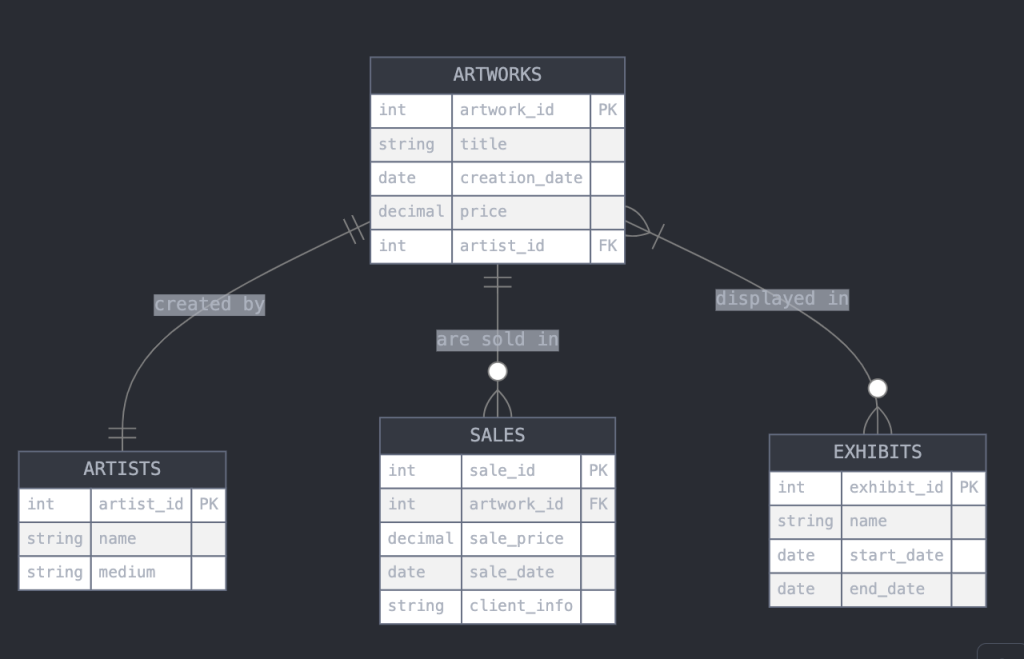Create an Art Gallery Database In 3 Steps
A Quick & Easy Guide on How to Create an Art Gallery Database
Managing artwork, tracking exhibits, and handling gallery-related tasks can be challenging without a structured system in place.
This is where an art gallery database comes in handy. Whether you’re a gallery manager or part of a team responsible for curating and organizing art, having a robust art database can make things easier.
An art gallery database stores essential information about artworks, such as artist details, exhibit history, pricing, and more.
Let’s dive in and learn how to create an art gallery database that suits your gallery’s needs.
Why Build an Art Gallery Database?
A well-organized art gallery database is essential for gallery operations. It helps you:
1. Track artwork and exhibit history: Know what’s in your collection, who the artist is, and the exhibit history of each piece.
2. Manage pricing and sales: Keep track of artwork pricing, sales history, and potential buyers.
3. Handle exhibits and artist relations: Efficiently manage upcoming exhibits, artist agreements, and ensure all details are correctly recorded.
4. Monitor artwork condition and appraisals: Track the condition of artworks, appraisals, and any restoration efforts.
Having all your gallery information in one place ensures that your team is on the same page, allowing for more efficient management of your collection and a better experience for your visitors and clients.
What Is an Art Gallery Database?
An art gallery database stores detailed information about your collection, including artist details, artwork titles, pricing, exhibit history, and sales records. It also tracks exhibit schedules, artist contracts, and condition reports.
Depending on your gallery’s needs, you might also track attributes like appraisals, restoration efforts, and client preferences. Additionally, you can monitor artist relations, gallery events, and any specific compliance requirements (e.g., “provenance documentation required,” “conservation records”).
Let’s say you’re managing a gallery. Your main system might handle the basics, like tracking sales and exhibit schedules. But it might not be great at keeping track of all the finer details, such as artwork condition, artist agreements, or compliance with regulations.
That’s where a proper art gallery database comes in handy. It’s like a one-stop shop for everything about your collection and gallery processes.
You can search it easily, and it keeps all the important info in one place. This makes it much easier to manage your gallery and ensure the smooth operation of exhibits.
Why Spreadsheets Fall Short for Art Gallery Databases
Let’s face it, many galleries start out tracking their artwork and exhibits in Excel or Google Sheets. It seems easy at first, especially when your collection is small. But as your gallery grows, these spreadsheets can cause some real headaches:
- Version Chaos: Before you know it, everyone’s got their own copy. You end up with a mess of files like “ArtCollection_LATEST,” “Exhibits_Updated,” “OldRecords_Ignore,” and so on. Who knows which one’s right?
- No Clear History: Without a proper system, it’s hard to keep track of who changed what and when. If the person in charge of updates leaves, you might be left wondering why certain changes were made.
- Data Gets Messy: People start adding their own notes, highlighting things, and making manual tweaks. Soon enough, you’ve got a rainbow of colors and comments that don’t make sense to anyone else. For example, someone might mark an artwork as “on loan” in one file, but others might miss it or misunderstand.
Using spreadsheets for your art gallery data goes against the whole point of having one trustworthy source of information. Instead of smoothly managing your collection, you end up playing detective with a bunch of conflicting spreadsheets.
Building a Real Art Gallery Database
Building a real art gallery database with a proper tool can solve these problems. It gives you one central place for all your gallery information that everyone can rely on. This ensures smoother operations, better collection management, and a more efficient gallery system.
How to Create an Art Database in 3 Steps
Let’s be real—if you’re managing an art gallery, you probably don’t have time to become a database expert. Normally, you’d need to fully understand concepts like SQL and how to build user interfaces. That’s a lot to ask when you’re busy overseeing exhibits, sales, and artist relations.
This is why many galleries put off creating a proper art gallery database. It just seems too complicated and time-consuming.
But here’s where tools like Five come in handy. It’s an online database builder that makes creating an art gallery database much simpler.
Now, I won’t lie—it’s not as easy as snapping your fingers. But it’s a whole lot easier than spending weeks learning to code from scratch.
With Five, you can:
- Quickly set up your art gallery database: Get a user-friendly interface without any extra work. It’s easy to import your existing data from Excel or other spreadsheets, so you don’t have to start from scratch.
- Add custom features: Create detailed reports about exhibits, sales, and artist relations, and set up charts to help you visualize your data at a glance. One of the most useful features is the ability to set up alerts for important dates like exhibit openings, contract renewals, or appraisals.
- Access your database from any device: Whether you’re in the gallery or working remotely, you can always access and manage your gallery data securely.
Want to give it a shot? Here’s how to get started:
- Sign up for free: Five offers a free trial to help you get started.
- Create your own art gallery database: Use a template or build from scratch—Five makes it easy.
- Add forms: Collect essential info like artist details, artwork pricing, and exhibit history.
- Set up logins for your team: Ensure secure access for gallery staff and managers.
With Five, managing your art gallery data becomes simple and efficient, allowing you to focus on what matters most—curating beautiful exhibits and supporting your artists.
Get free access to Five here and start building your art gallery database today.
Five has a team of experts ready to assist you. So, if you ever feel like you’re in over your head, don’t worry, our expert developers are here to help. And yes, we promise not to charge you an arm and a leg or leave you with a system that only we understand. To get a free consultation, visit this page: “Hire An Expert.”
Step 1: What Do You Need to Know About Your Art Collection?
First things first, think about what information you really need to track your art collection effectively. What matters most to your gallery? What do your artists, curators, and staff care about? You want your art gallery database to be the go-to place for all this information, so make it as comprehensive as possible.
Here’s a list of things you might want to keep track of:
- Artwork ID and Title
- Artist Name and Background
- Creation Date and Medium
- Exhibit History and Current Status (on display, in storage, etc.)
- Pricing and Sales Records
- Condition Reports and Restoration History
- Provenance and Documentation
- Location and Storage Details
- Exhibit Dates and Details
- Contact Information for Artists and Clients
Step 2: Think About How You Manage Your Art Collection
Your art gallery database isn’t just a list—it’s a tool that should help you manage your collection and gallery operations day-to-day. Consider tracking:
- Artwork Lifecycle: Record key milestones such as acquisitions, sales, and restorations.
- Exhibit Management: Keep notes on exhibit schedules, artwork placements, and any special requirements.
- Compliance and Legal Requirements: Monitor compliance with provenance documentation, track conservation efforts, and ensure all necessary records are up-to-date.
- Sales and Pricing Management: Track artwork pricing, sales history, and client transactions to ensure accurate financial records.
- Artist Relations and Communication: Collect and manage information on artists, their preferences, and their agreements with your gallery.
The more detailed your records, the more valuable your database will become. For example, if you want to analyze exhibit trends, ensure compliance with documentation requirements, or manage artist relations effectively, you’ll need to have been recording that data consistently.
Remember, a good art gallery database evolves with your gallery’s needs. Start with the essentials, and you can always add more detail as your operations grow.
Step 3: Creating Your Art Gallery Database
With your list of artwork attributes and additional information ready, it’s time to move all of this into a proper database.
To do so, sign up for Five, an online database builder that comes with a simple point-and-click interface for creating relational databases.
Follow our video tutorial to build your database tables, forms, and reports, and start managing your gallery’s art collection efficiently.
The Art Gallery Database Schema
Here’s the database schema for your art gallery application:
- Artworks Table: At the core of the database, this table stores information about each artwork, such as title, artist, creation date, and pricing.
- Artists Table: This table helps classify artworks by artist, making it easier to organize and retrieve records based on artist or medium.
- Exhibits Table: A critical component of the schema, this table links artworks to their exhibit records, allowing you to track exhibit history and current status.
- Sales Table: This table tracks artwork sales, pricing, and client transactions.
Each table holds specific information, such as artwork details, exhibit records, and sales data, ensuring a comprehensive and organized structure. The relationships between these tables facilitate efficient gallery management, making it easier to track artwork progress, manage sales, and provide an optimal experience for your artists and clients.

With your art gallery database set up in Five, you’ll have a powerful tool to manage your collection, track exhibit details, and keep your gallery operations running smoothly.
Art Gallery Database: Key Features
A Customizable Art Gallery Database
Using Five’s Table Wizards, you can transform your art gallery database’s table and field definitions into a fully functional system. Five, an online database builder, offers a user-friendly, point-and-click design tool that even non-technical users can quickly master. Add as many fields as you need to your art gallery database, ensuring it meets the specific requirements of your gallery, whether it’s tracking artwork details, exhibit history, or sales records.
Simple-to-Use Forms
Five allows you to add forms, making it easy to enter and manage data in your art gallery database. These forms enable you to store or retrieve information, such as artwork details or exhibit schedules, with ease. Additionally, you can create charts, dashboards, or even PDF reports, perfect for generating sales summaries, exhibit catalogs, or artist profiles.
Login Protected and Secure
Securing your art gallery data is crucial. Five includes a pre-built authentication feature that adds a login screen to your application. Only registered users with valid credentials can view or edit data. You can also enable multi-factor authentication for extra security, ensuring that your art gallery data remains protected and accessible only to authorized personnel.
Generate Documents
Five allows you to generate documents directly within the application. You can easily create sales reports, exhibit catalogs, or artist agreements and build workflows for approval or distribution, streamlining your gallery management process.
Searchable and Online
Your art gallery database is searchable and hosted online, making it accessible from any device at any time. This ensures that your gallery team can stay connected and up-to-date on artwork data and operations, whether they’re in the gallery or working remotely.
Get Started with Five Today
To build your art gallery database with Five, sign up for free access and start the process. If you need assistance, visit our forum to get help from our application development experts as you add more features to your database application.
By following the steps mentioned above, you can create art gallery management software tailored to your needs, all while using the tools provided by Five.



